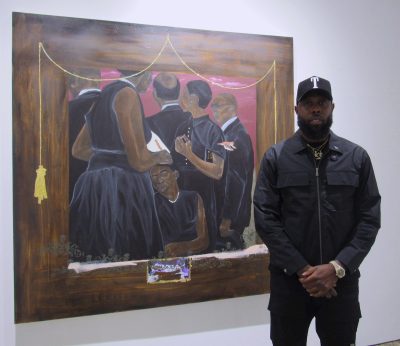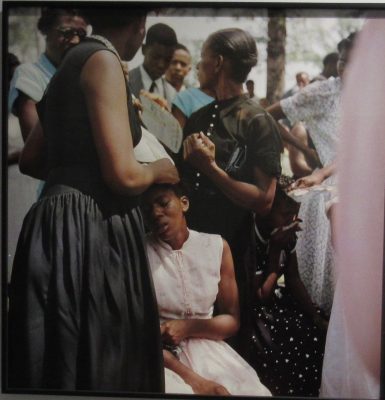Artist Captures His View of Southern Black Life at Gordon Parks Exhibit
News Based on facts, either observed and verified directly by the reporter, or reported and verified from knowledgeable sources.

The Black church has always played a crucial role in African American history, especially in the South where, to this day, a strong church community fights racial injustices.
Powerful segregation era pictures by groundbreaking Black photographer Gordon Parks (1912-2006) captured the essence of Southern Black life in his 1956 series “Segregation Story.”
Parks has long inspired writers and artists since the 1940s, including Jammie Holmes, a self-taught painter, who has recreated some of Parks’ images on canvas. “Jammie Holmes: Church Folks” is the current exhibit at The Gordon Parks Foundation Gallery in Pleasantville. Holmes was honored there last week for receiving a 2023 Gordon Parks Foundation Fellowship. Also honored were artist José Parlá and art historian and scholar Melanee C. Harvey.
Holmes, 40, was born and raised in Thibodaux, La., an impoverished and marginalized community. As a youngster, Holmes was always sketching his family members. It was his go-to muse, a delight he never gave up.
Growing up, art museums and galleries were foreign to Holmes, and since there were no educational avenues for artistic youngsters in Thibodaux, Holmes assumed that after graduating high school he would work at a local manufacturing company or in the oil fields.
“As a boy there were no schools for art where I grew up,” he recalled. “Folks got jobs in the local mills, the sugar cane fields or the nuclear plant. I ended up working in a Texas oil field for 13 years.”
Holmes is warm and personable and speaks openly about his art and life. He moved to Dallas in 2016, and a year later discovered the Modern Art Museum of Fort Worth. The visit prompted his dramatic art trajectory, using his innate talent of detailed pencil sketching on paper to mastering a more viscous material on canvas.
“I was 35 and a late bloomer when I started to paint,” he explained. “I bought cheap paint and for the first time I was expressing myself. I strive to get my point across.”
The more he painted Holmes realized he had the perfect vehicle to weave his personal experience into his work with each brush stroke.

“My work is partially my story,” he said. “It’s important for me to show how I truly feel.”
His first participation in a group show in Los Angeles in 2019 garnered serious recognition, catapulting him in the art world. That same year he was able to support himself with his work.
Holmes said when he first learned of Parks’ contributions, the renowned photographer became his role model.
“I have three Gordon Parks photographs that I love, and although I never knew him, I read how obsessed he was about wanting to document history. I try to work his essence into my paintings to feel a certain way.”
Holmes’ painting from last year, “Church Folks,” was inspired by a 1956 Parks photograph of a church community in Shady Grove, Ala. The picture, currently on view at the foundation’s gallery, shows a woman standing dressed in black cradling the head of seated women in white who is distressed and crying. In Holmes’ painted version, a large thickly-framed square seems as if you are looking out a window to the same scene. Here, everyone is wearing black and looking away from the viewer, including the three male figures in the background that Holmes added.
Contrasting the indelible somber mood is one of Holmes’ signature marks of glitter and draped, gold leaf tassels. An olive green, delicate lace motif at the bottom and a sparrow mid-flight suggests a connection to hope.
For Holmes, the sparrow is a symbol of peace and appears in other works.
“The sparrows are what I grew up with in Thibodaux,” he said. “My grandmother had a bush in front of her house and there were always several sparrows in that bush. That memory is a peaceful one.”

Abby is a seasoned journalist who has been covering news and feature stories in the region for decades. Since The Examiner’s launch in 2007, she has reported extensively on a broad range of community issues. Read more from Abby’s editor-author bio here. Read Abbys’s archived work here: https://www.theexaminernews.com/author/ab-lub2019/
